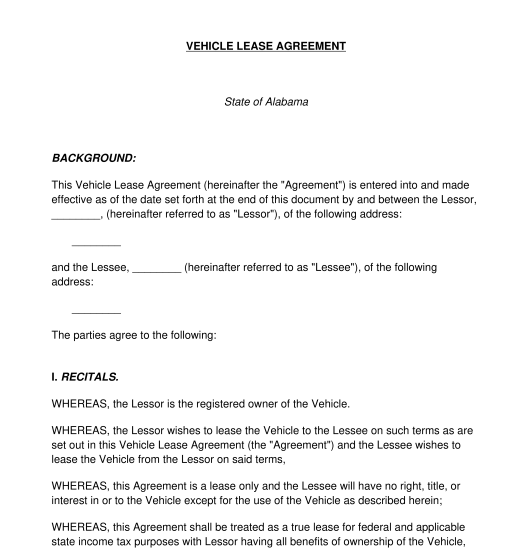 01/03/2025
01/03/2025

Answer a few questions and your document is created automatically.

Your document is ready! You will receive it in Word and PDF formats. You will be able to modify it.




Rating: 4.9 - 416 votes
Download a basic template (FREE) Create a customized documentA vehicle lease agreement is a document used to reflect a contract made between a vehicle owner, known as the lessor, and someone who pays the owner to possess and use the vehicle for a predetermined period of time, known as the lessee. A vehicle lease agreement is most commonly used with new and pre-owned cars, trucks, and motorcycles. However, the agreement may also be used with any other motor vehicle that has a Vehicle Identification Number (VIN) and license plate. Using a vehicle lease agreement protects both parties from any misunderstandings or miscommunications that may arise during the life of the lease by providing written documentation of the lease terms.
Though both documents are used for vehicles, they have different purposes. A vehicle lease agreement is used by someone who would like to borrow a car for a set period of time before returning it to the original owner. A vehicle sale agreement is used by someone who would like to buy and permanently own a vehicle.
No, it is not mandatory to use a vehicle lease agreement. Two people can have an informal arrangement where one borrows the car from the other. However, though a vehicle lease agreement is not mandatory, it is highly advisable to create one as it works to make sure both parties understand the details of the borrowing arrangement. It acts as protection for one or both of the parties in case there is a problem or future dispute related to the arrangement.
A vehicle identification number, commonly referred to as a VIN, is a unique number assigned to every vehicle. The VIN is located in several places both on the vehicle as well as on the titles, insurance policies, and service records for the vehicle.
A security deposit is money paid upfront to the vehicle lessor that is then returned to the lessee if and when the vehicle is returned to the lessor in good condition. This money may also be applied to the purchase price if the lessor elects to buy the vehicle after the lease is over.
A down payment is a form of payment that is made at lease-signing that is meant to reduce the monthly amount of the lease.
GAP coverage is a form of insurance that covers the difference between the amount the lessee owes on the car loan and the car's estimated value. This is particularly helpful in case the lessee is involved in an accident while driving the leased vehicle. In the event of an accident, the fair market value of the vehicle becomes a lot lower.
For example, a lease price of a car is $20,000 and several months later the vehicle is involved in an accident, but $15,000 is still owed on the lease. The insurer estimates that the new fair market value of the vehicle is $9,000. The lessee is now left with a $6,000 difference that will need to be accounted for in addition to the fees and terms outlined in the vehicle lease agreement. Standard insurance will help, but additional GAP coverage helps eliminate this deficit, saving the lessee from potential financial problems.
Once the document is complete, both the lessor and lessee should sign and date the vehicle lease agreement. In most states, the document does not need to be notarized or witnessed to be legally binding. However, in Louisiana, Maryland, Wyoming, Nebraska, and West Virginia the document should be signed in front of a notary and notarized to be legally binding on the parties. The parties should each save a copy of the vehicle lease agreement in their files for future reference and in case of dispute or disagreement.
A valid vehicle lease agreement must contain at least the following mandatory sections:
In addition to the above mandatory information, the following information may also be included:
Vehicle lease agreements, like other lease and general purpose sale agreements, in the United States, are generally subject to both federal law and state specific laws, which cover general contract principles like formation and mutual understanding. Federal law dictates that a vehicle lease agreement must include a disclosure by the seller of the vehicle's odometer reading at the time of the leasing. Further, state laws cover commercial transactions and business. For example, in Louisiana, Maryland, Nebraska, Wyoming, and West Virginia, a vehicle lease agreement must be certified by a notary.
You fill out a form. The document is created before your eyes as you respond to the questions.
At the end, you receive it in Word and PDF formats. You can modify it and reuse it.
A guide to help you: Is it Better to Lease or Buy a Car?
Vehicle Lease Agreement - FREE - Sample, template
Country: United States